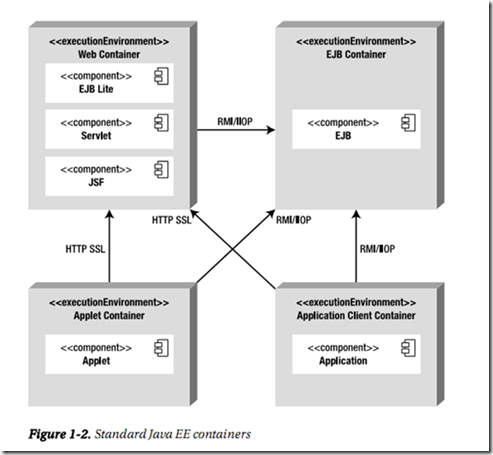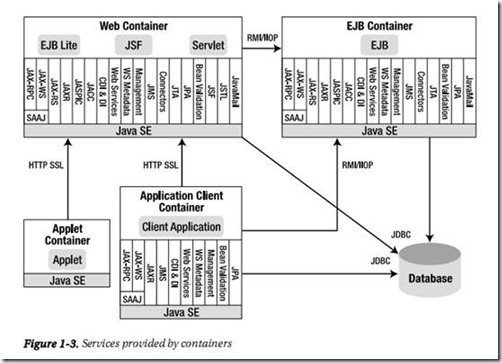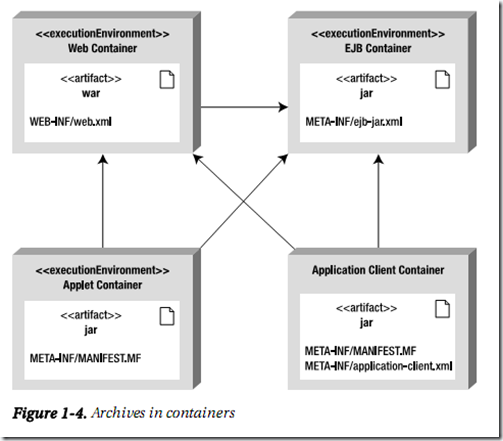上篇文章对Java的基本概念作了简要总结(http://www.cnblogs.com/2018/archive/2011/04/05/1993163.html),本文把对java EE的学习过程总结一下。
基础
https://javaeetutorial.dev.java.net/files/documents/7232/141115/javaeetutorial6.zip
这个里面有介绍文档和例子代码,这些例子在netbeans可直接打开,参考文档部署和运行
这个文档介绍了整个Java EE的基本概念和示范例子,熟悉这个基本对Java EE的概念就比较了解了。
Java EE的基本概念
实际的开发中,只要理解了下面的几个图表和规范,只要针对具体的规范和标准进行学习即可。因为本身Java EE规范范围很大,我们实际中用的只是其中的部分。
【以下是做的一些图书资料记录,我认为很重要】
Java EE is based on standards.
Containers are Java EE runtime environments that provide certain services to the components they host such as life-cycle management, dependency injection, and so on. These components use well-defined contracts to communicate with the Java EE infrastructure and with the other components.
containers
Applet containers are provided by most web browsers to execute applet components. When you develop applets, you can concentrate on the visual aspect of the application while the container givesou a secure environment. The applet container uses a sandbox security model where code executed inhe “sandbox” is not allowed to “play outside the sandbox.” This means that the container prevents anyode downloaded to your local computer from accessing local system resources, such as processes oriles.
The application client container (ACC) includes a set of Java classes, libraries, and other files required to bring injection, security management, and naming service to Java SE applications (Swing,atch processing, or just a class with a main() method). ACC communicates with the EJB container usingRMI-IIOP and the web container with HTTP (e.g., for web services).
The web container provides the underlying services for managing and executing web componentsservlets, EJBs Lite, JSPs, filters, listeners, JSF pages, and web services). It is responsible for instantiating,nitializing, and invoking servlets and supporting the HTTP and HTTPS protocols. It is the containersed to feed web pages to client browsers.
The EJB container is responsible for managing the execution of the enterprise beans containing theusiness logic tier of your Java EE application. It creates new instances of EJBs, manages their life cycle, and provides services such as transaction, security, concurrency, distribution, naming service, or theossibility to be invoked asynchronously.
Services
Containers provide underlying services to their deployed components.
• Java Transaction API (JTA): This service offers a transaction demarcation API usedby the container and the application. It also provides an interface between thetransaction manager and a resource manager at the Service Provider Interface(SPI) level.
• Java Persistence API (JPA): Standard API for object-relational mapping (ORM). With its Java Persistence Query Language (JPQL), you can query objects stored in the underlying database.
• Validation: Bean Validation provides a class level constraint declaration and validation facility.
• Java Message Service (JMS): This allows components to communicate asynchronously through messages. It supports reliable point-to-point (P2P) messaging as well as the publish-subscribe (pub-sub) model.
• Java Naming and Directory Interface (JNDI): This API, included in Java SE, is used to access naming and directory systems. Your application uses it to associate (bind) names to objects and then to find these objects (lookup) in a directory. You can look up datasources, JMS factories, EJBs, and other resources. Omnipresent in your code until J2EE 1.4, JNDI is used in a more transparent way through injection.
• JavaMail: Many applications require the ability to send e-mails, which can be implemented through use of the JavaMail API.
• JavaBeans Activation Framework (JAF): The JAF API, included in Java SE, provides a framework for handling data in different MIME types. It is used by JavaMail.
• XML processing: Most Java EE components can be deployed with optional XML deployment descriptors, and applications often have to manipulate XML documents. The Java API for XML Processing (JAXP) provides support for parsing documents with SAX and DOM APIs, as well as for XSLT. The Streaming API for XML (StAX) provides a pull-parsing API for XML.
• Java EE Connector Architecture (JCA): Connectors allow you to access EIS from a Java EE component. These could be databases, mainframes, or Enterprise Resource Planning (ERP) programs.
• Security services: Java Authentication and Authorization Service (JAAS) enables services to authenticate and enforce access controls upon users. The Java Authorization Service Provider Contract for Containers (JACC) defines a contract between a Java EE application server and an authorization service provider, allowing custom authorization service providers to be plugged into any Java EE product.
• Web services: Java EE provides support for SOAP and RESTful web services. The Java API for XML Web Services (JAX-WS), replacing the Java API for XML-based RPC (JAX-RPC), provides support for web services using the SOAP/HTTP protocol. The Java API for RESTful Web Services (JAX-RS) provides support for web services using the REST style.
• Dependency injection: Since Java EE 5, some resources (datasources, JMS factories, persistence units, EJBs…) can be injected in managed components. Java EE 6 goes further by using CDI (Context and Dependency Injection) as well as the DI (Dependency Injection for Java) specifications.
• Management: Java EE defines APIs for managing containers and servers using a special management enterprise bean. The Java Management Extensions (JMX) API is also used to provide some management support.
• Deployment: The Java EE Deployment Specification defines a contract between deployment tools and Java EE products to standardize application deployment.
参考资料
Java EE 6规范中文版.chm
Java+EE+6+API+Specifications.CHM
javadocee6.zip
servlet-2_3-fcs-docs.zip
javaeetutorial6.zip[The Java EE 6Tutorial]
The Java EE 6 Tutorial Basic Concepts, 4th Edition
Beginning Java EE 6 with GlassFish 3, 2nd Edition
这些资料在网上都可以找到
例子实战
http://netbeans.org/kb/docs/javaee/ecommerce/design.html
很实用的一个例子,覆盖了多个方面的内容,理解了这个基本对如何实施一个Java EE的项目就有一个比较清晰的概念了。
Java EE发展了十几年,相关的资料和开源框架等浩如烟海,我们只要把握这些基础的概念,然后结合相应的实例学习和开发改造,在项目中就可以顺利应用了。


